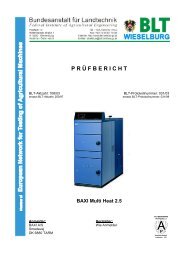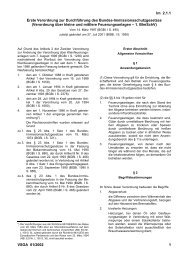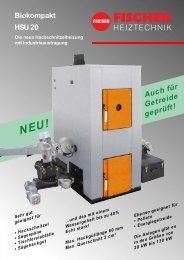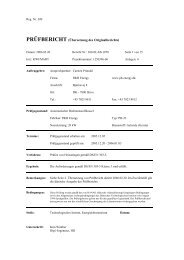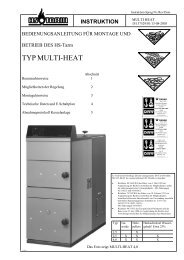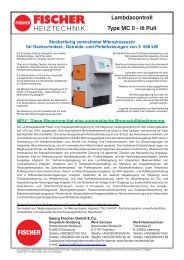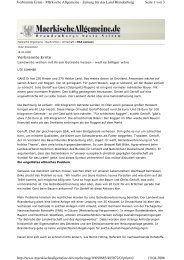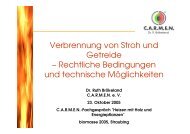Development of 0.5 MWe Scale DeSOX-DeNOX ... - Getreideheizung
Development of 0.5 MWe Scale DeSOX-DeNOX ... - Getreideheizung
Development of 0.5 MWe Scale DeSOX-DeNOX ... - Getreideheizung
Create successful ePaper yourself
Turn your PDF publications into a flip-book with our unique Google optimized e-Paper software.
2. Removal <strong>of</strong> SO 2<br />
Fig. 7 shows the removal <strong>of</strong> SO 2 as a function <strong>of</strong> the molar ratio <strong>of</strong> NH 3 to SO 2 in<br />
flue gas. In this test, peak values <strong>of</strong> applied voltage and current and pulse repetition rate<br />
were 43.6 kV, 0.35 kA, and 90 pps, respectively. A variation <strong>of</strong> consumption <strong>of</strong> the<br />
electrical energy was constant during SO 2 removal tests.<br />
Without injection <strong>of</strong> NH 3 , the removal rate was only about 8 %. In general, the<br />
efficiency <strong>of</strong> SO 2 removal by a gas phase radical reaction is known only to be about 10<br />
%. Although the removal process <strong>of</strong> SO 2 is mainly governed by the thermochemical<br />
reaction with ammonia and the heterogeneous chemical reaction, it can be enhanced by<br />
the pulsed streamer corona process [11]. When only NH 3 was injected into the gas with<br />
a 2:1 molar ratio to the initial SO 2 concentration, about 294 ppm <strong>of</strong> the initial 300 ppm<br />
SO 2 was removed. However, care must be taken with regards to secondary pollution<br />
production due to unreacted NH 3 . During this experiment, emissions <strong>of</strong> NH 3 were<br />
detected up to 26 ppm. In addition, there must have been an unreacted additive even<br />
though we did not measure it. One <strong>of</strong> the methods that can reduce the emission <strong>of</strong> NH 3<br />
as well as that <strong>of</strong> chemical additives is to modify the injection method or positions <strong>of</strong><br />
NH 3 or chemical additives such as using a corona radical shower method [12].<br />
100<br />
50<br />
SO2 Removal Rate (%)<br />
80<br />
60<br />
40<br />
20<br />
40<br />
30<br />
20<br />
10<br />
NH 3 Concentration (ppm)<br />
0<br />
0<br />
0 <strong>0.5</strong> 1 1.5 2 2.5<br />
Ratio (NH3/SO2)<br />
Fig 7. SO 2 removal rate(g) as a function <strong>of</strong> the molar ratio <strong>of</strong> NH 3 to SO 2 and<br />
emission <strong>of</strong> unreacted NH 3 (n) at outlet <strong>of</strong> the reactor. The gas<br />
consisted <strong>of</strong> 18 % O 2 and 38 ppm CO. The flow rate and temperature<br />
<strong>of</strong> the gas were 1,200 Nm 3 /h and 118 o C, respectively.<br />
3. Removal <strong>of</strong> NO X<br />
The tests were carried out to clarify the effect <strong>of</strong> the hydrocarbon additive, C 2 H 4 , and<br />
the energy input into the reactor on NO X removal efficiency. Fig. 8 shows the removal<br />
rates <strong>of</strong> NO, NO 2 , and NO X with and without the addition <strong>of</strong> C 2 H 4 in flue gas. The<br />
initial concentration <strong>of</strong> NO X was (a) 245 ppm and (b) 312 ppm, and the voltage pulses




